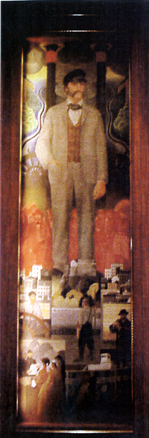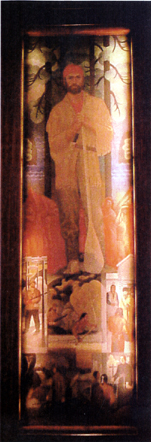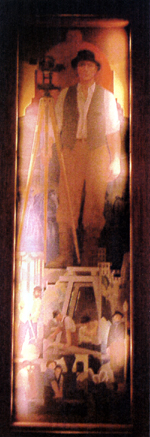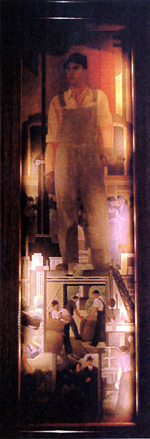Difference between revisions of "Ramsey Co. Courthouse/St. Paul City Hall"
(table +table) |
|||
| Line 10: | Line 10: | ||
! | ! | ||
|- | |- | ||
| − | | [[Image:Svc_rmco-boat.jpg]] "The Steamboat Captain" | + | | <div style="text-align: center;"> |
| + | [[Image:Svc_rmco-boat.jpg]] | ||
| + | </div> <div style="text-align: center;"> | ||
| + | <small>'''"The Steamboat Captain" Courtesy of the [[Jean-Nickolaus Tretter Collection]].'''</small> | ||
| + | </div> | ||
| The City of St. Paul prepared for its current home shortly before the stock market crash of 1929. The Depression did not stop the project; instead, it altered the building’s design and construction—it became a site of employment for the Civil Works Administration (CWA) and later the Works Progress Administration (WPA). These federal agency employed the talents of architects, sculptors, painters, and other artists to produce patriotic visions of the future. | | The City of St. Paul prepared for its current home shortly before the stock market crash of 1929. The Depression did not stop the project; instead, it altered the building’s design and construction—it became a site of employment for the Civil Works Administration (CWA) and later the Works Progress Administration (WPA). These federal agency employed the talents of architects, sculptors, painters, and other artists to produce patriotic visions of the future. | ||
| Line 18: | Line 22: | ||
Haupers’ sexual orientation likely influenced the federally-funded artwork of all WPA projects in Minnesota, which includes: the Minneapolis and St. Paul main post offices; “The Pioneers,” a former centerpiece of Minneapolis’ demolished Pioneer Square; the Minneapolis Armory, and scores of other small projects throughout the state. | Haupers’ sexual orientation likely influenced the federally-funded artwork of all WPA projects in Minnesota, which includes: the Minneapolis and St. Paul main post offices; “The Pioneers,” a former centerpiece of Minneapolis’ demolished Pioneer Square; the Minneapolis Armory, and scores of other small projects throughout the state. | ||
| − | | [[Image:Svc_rmco-log.jpg]] "The Lumberjack" | + | | <div style="text-align: center;"> |
| + | [[Image:Svc_rmco-log.jpg]] | ||
| + | </div> <div style="text-align: center;"> | ||
| + | <small>'''"The Lumberjack" Courtesy of the [[Jean-Nickolaus Tretter Collection]].'''</small> | ||
| + | </div> | ||
|} | |} | ||
| Line 27: | Line 35: | ||
! | ! | ||
|- | |- | ||
| − | | [[Image:Svc_rmco-survey.jpg]] "The surveyor" | + | | <div style="text-align: center;"> |
| + | [[Image:Svc_rmco-survey.jpg]] | ||
| + | </div> <div style="text-align: center;"> | ||
| + | <small>'''"The surveyor" Courtesy of the [[Jean-Nickolaus Tretter Collection]].'''</small> | ||
| + | </div> | ||
| In many cases, the artists deployed unique renditions of a style known today as American Social Realism. The style is a further development of the Art Deco period; it deploys sharp angles, streamlined aesthetics, and geometric shapes and depicts modes of transportation, personifications of the working class, and (racially insensitive) depictions of American history. | | In many cases, the artists deployed unique renditions of a style known today as American Social Realism. The style is a further development of the Art Deco period; it deploys sharp angles, streamlined aesthetics, and geometric shapes and depicts modes of transportation, personifications of the working class, and (racially insensitive) depictions of American history. | ||
| Line 40: | Line 52: | ||
Four painted panels stand out in this regard; they present influential characters in St. Paul history—the steamboat captain, lumberjack, surveyor, and machinist<small>(3)</small>—that predated the Village People’s similar presentation by four decades. Possibly, Haupers used his status to employ his artist friends whom were “in the know.” | Four painted panels stand out in this regard; they present influential characters in St. Paul history—the steamboat captain, lumberjack, surveyor, and machinist<small>(3)</small>—that predated the Village People’s similar presentation by four decades. Possibly, Haupers used his status to employ his artist friends whom were “in the know.” | ||
| − | | [[Image:Svc_rmco-machine.jpg]] "The Machinist" | + | | <div style="text-align: center;"> |
| + | [[Image:Svc_rmco-machine.jpg]] | ||
| + | </div> <div style="text-align: center;"> | ||
| + | <small>'''"The Machinist" Courtesy of the [[Jean-Nickolaus Tretter Collection]].'''</small> | ||
| + | </div> | ||
|} | |} | ||
| − | |||
| − | |||
| − | |||
Revision as of 16:26, 4 March 2010
15 Kellogg Boulevard West, St. Paul, MN
| "The Steamboat Captain" Courtesy of the Jean-Nickolaus Tretter Collection. |
The City of St. Paul prepared for its current home shortly before the stock market crash of 1929. The Depression did not stop the project; instead, it altered the building’s design and construction—it became a site of employment for the Civil Works Administration (CWA) and later the Works Progress Administration (WPA). These federal agency employed the talents of architects, sculptors, painters, and other artists to produce patriotic visions of the future.
|
"The Lumberjack" Courtesy of the Jean-Nickolaus Tretter Collection. |
| "The surveyor" Courtesy of the Jean-Nickolaus Tretter Collection. |
In many cases, the artists deployed unique renditions of a style known today as American Social Realism. The style is a further development of the Art Deco period; it deploys sharp angles, streamlined aesthetics, and geometric shapes and depicts modes of transportation, personifications of the working class, and (racially insensitive) depictions of American history.
|
"The Machinist" Courtesy of the Jean-Nickolaus Tretter Collection. |
(1)Johnston, Gerry. Interview with Jean-Nicklaus Tretter, Fall 1999. Mr. Johnston was Hauper’s estate dealer and personally knew him, and reported his sexual orientation to Tretter.
(2)Tretter, Jean-Nickolaus. “Homosocial Coding in WPA Art” Paper submitted to the University of Minnesota, 1999.
(3)Tretter, pages 14-15.



